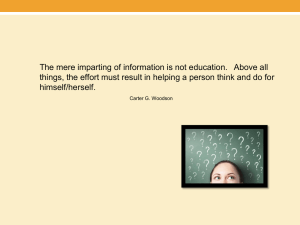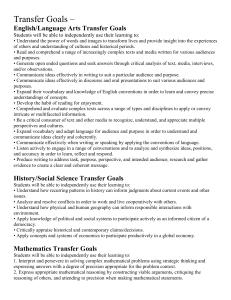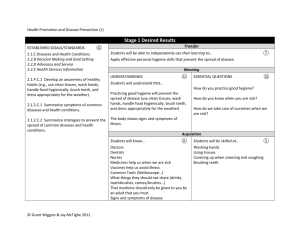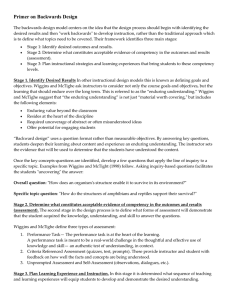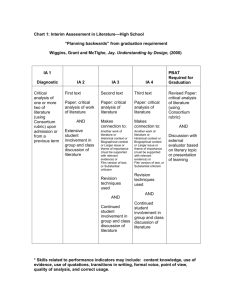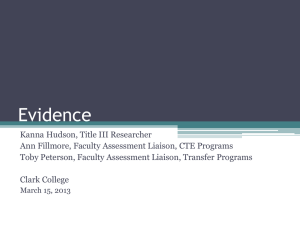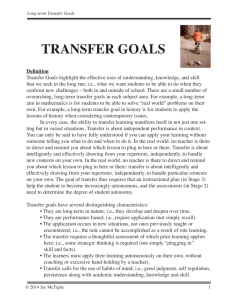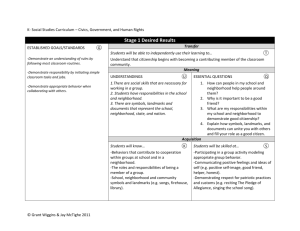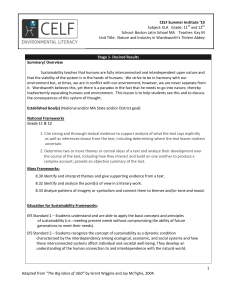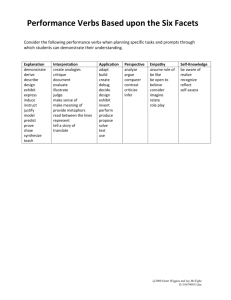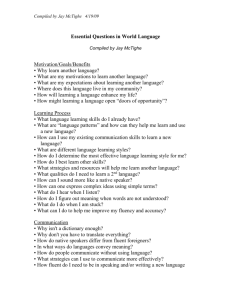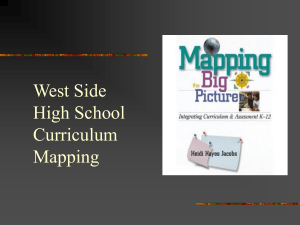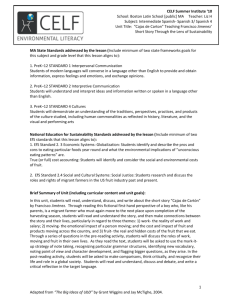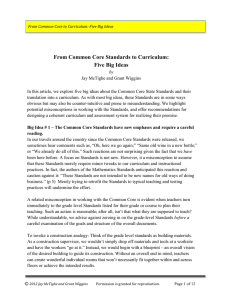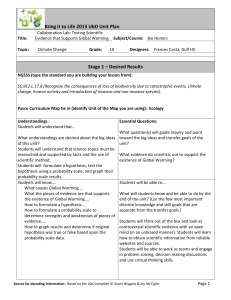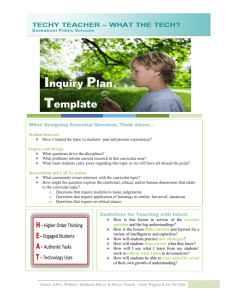Transfer Goals Clarification Feb 2012
advertisement
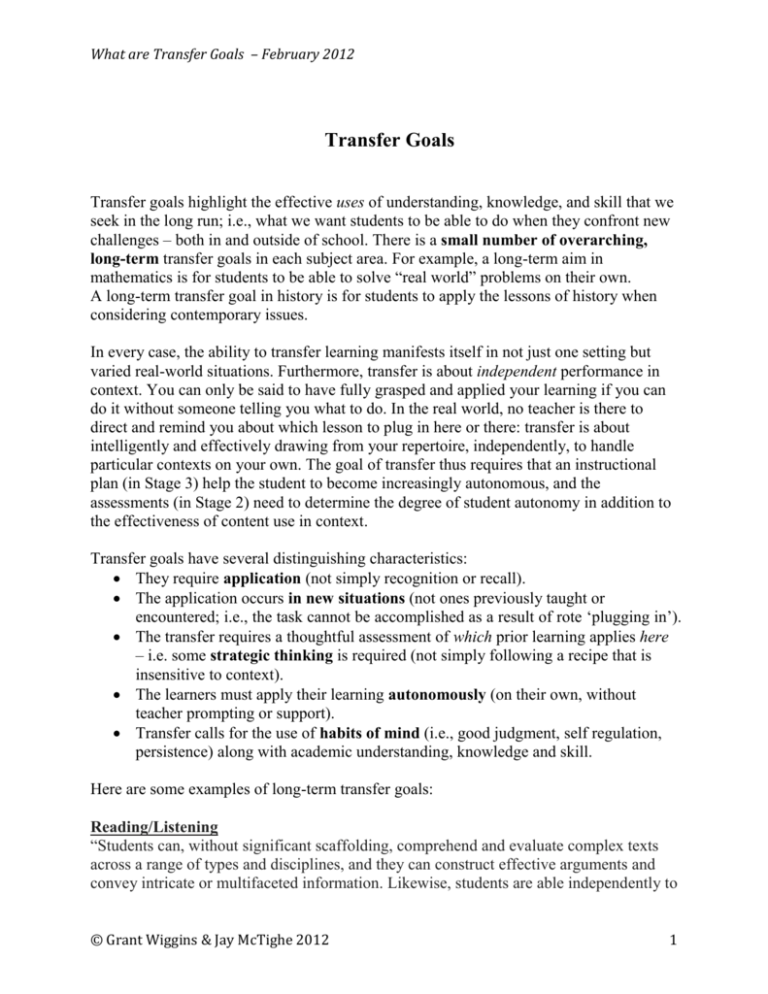
What are Transfer Goals – February 2012 Transfer Goals Transfer goals highlight the effective uses of understanding, knowledge, and skill that we seek in the long run; i.e., what we want students to be able to do when they confront new challenges – both in and outside of school. There is a small number of overarching, long-term transfer goals in each subject area. For example, a long-term aim in mathematics is for students to be able to solve “real world” problems on their own. A long-term transfer goal in history is for students to apply the lessons of history when considering contemporary issues. In every case, the ability to transfer learning manifests itself in not just one setting but varied real-world situations. Furthermore, transfer is about independent performance in context. You can only be said to have fully grasped and applied your learning if you can do it without someone telling you what to do. In the real world, no teacher is there to direct and remind you about which lesson to plug in here or there: transfer is about intelligently and effectively drawing from your repertoire, independently, to handle particular contexts on your own. The goal of transfer thus requires that an instructional plan (in Stage 3) help the student to become increasingly autonomous, and the assessments (in Stage 2) need to determine the degree of student autonomy in addition to the effectiveness of content use in context. Transfer goals have several distinguishing characteristics: They require application (not simply recognition or recall). The application occurs in new situations (not ones previously taught or encountered; i.e., the task cannot be accomplished as a result of rote ‘plugging in’). The transfer requires a thoughtful assessment of which prior learning applies here – i.e. some strategic thinking is required (not simply following a recipe that is insensitive to context). The learners must apply their learning autonomously (on their own, without teacher prompting or support). Transfer calls for the use of habits of mind (i.e., good judgment, self regulation, persistence) along with academic understanding, knowledge and skill. Here are some examples of long-term transfer goals: Reading/Listening “Students can, without significant scaffolding, comprehend and evaluate complex texts across a range of types and disciplines, and they can construct effective arguments and convey intricate or multifaceted information. Likewise, students are able independently to © Grant Wiggins & Jay McTighe 2012 1 What are Transfer Goals – February 2012 discern a speaker’s key points, request clarification, and ask relevant questions…” Source: Common Core – College and Career Ready Standards for Reading Writing Effectively write for various audiences and purposes; e.g., to explain (narrative, expository), entertain (creative), persuade (persuasive), help perform a task (technical), and challenge or change things (satirical). Mathematics Recognize and solve practical or theoretical problems involving mathematics, including those for which the solution approach is not obvious, using mathematical reasoning, tools and strategic thinking. Science • Evaluate scientific claims (e.g., XX brand of paper towels absorbs the most liquid of all the leading brand), and analyze current issues involving science or technology (e.g., Ethanol is the most cost-effective alternative fuel source.) • Conduct a new and effective scientific inquiry to explain a phenomena, answer a question, test or confirm a hypothesis. (not just do a canned ‘lab’ in a science classroom) History • Apply the lessons of the past (patterns of history) to: - better understand other historical/current events and issues; - anticipate and prepare for the future. • Critically appraise historical and contemporary claims/decisions. • Participate actively and effectively as an informed citizen of a democracy. Health and Physical Education • Live a healthy life by making healthful choices and decisions regarding diet, exercise, stress management, alcohol/drug use. • Participate in activities that promote wellness throughout life. World Language Communicate effectively in the target language, in varied situations, while displaying a sensitivity to culture and context. Visual and Performing Arts • Find meaning in works of art. • Create and perform an original work in a selected medium to express ideas and/or to evoke mood and emotion. • Seek out and appreciate the arts throughout life. © Grant Wiggins & Jay McTighe 2012 2 What are Transfer Goals – February 2012 Often, long-term transfer goals such as these can be found in the “front matter” of standards documents (such as the Reading example above) or stated directly in the top-level of a Standards document hierarchy (as opposed to the more specific grade-level Standards). How do we know that we have identified appropriate transfer goals? We propose the following criteria for evaluating Transfer goals. Do the proposed Transfer goals – specify genuine performance applications in new situations? require a thoughtful application; i.e. some strategic thinking is required? require autonomous performance by the learner (i.e., on their own, without coaching or teacher support)? distinguish performance outcomes (ends) from enabling knowledge and skills (the means)? Transfer Goals in Curriculum Planning Long-term overarching Transfer goals specify important outcomes for programs of study (e.g., pre-K to 12 mathematics). They serve as end points from which a curriculum should be “backward mapped.” However, practical questions have surfaced as people began using the UbD Template 2.0 in designing curriculum units. Here are common questions we hear: How big and long-term should these goals be? Should there also be specific transfer goals for a unit? How many transfer goals should we list in a unit? We recommend that in unit planning, educators – 1. Identify one or two established long-term Transfer goals. Since these are long-term, they may not be attained within a single unit. However, we think it is critical that teachers (even of young children) have long-term ends in mind so as not to fixate too narrowly on “covering” content objectives or getting “lost in the weeds” by teaching and assessing discrete and de-contextualized skills. 2. Then, if appropriate, identify one or more specific, shorter-term unit goals that require transfer. Here is one suggested format with two examples: Example #1 – Common Core College and Career Readiness Standards – Writing © Grant Wiggins & Jay McTighe 2012 3 What are Transfer Goals – February 2012 Students will be able to independently use their learning to... Write arguments to support claims in an analysis of substantive topics or texts, using valid reasoning and relevant and sufficient evidence. In this unit… Students will write a persuasive letter using relevant evidence to support their position on a school or community issue. Example #2 – Mathematics Students will be able to independently use their learning to... Recognize and solve practical or theoretical problems involving mathematics, including those for which the solution approach is not obvious, by using mathematical reasoning and strategic thinking. In this unit… Students will solve real-world problems involving ratio and proportion. Here is a suggested frame for framing transfer goals within units: Students will apply their understanding of meaningful and novel context or contexts) x to do y (in a While the UbD Template asks for Transfer Goals to be identified in Stage 1, it is the intent that “transfer” be reflected throughout the unit plan in all three stages. In Stage 2, we expect to see one of more Performance Tasks that involve transfer. Indeed, one of the virtues of Transfer Goals is that they naturally suggest needed assessment evidence. Then, the Learning Plan in Stage 3 should include learning experiences designed to equip students for increasingly autonomous performance on the transfer task(s), and not simply present content knowledge and skills to be acquired and tested for recall. In sum, the Transfer Goals identified in Stage 1 should point toward the most important long-term performance outcomes identified in the Standards, guide the development of needed assessment tasks in Stage 2, and encourage teaching and learning for transfer. © Grant Wiggins & Jay McTighe 2012 4
